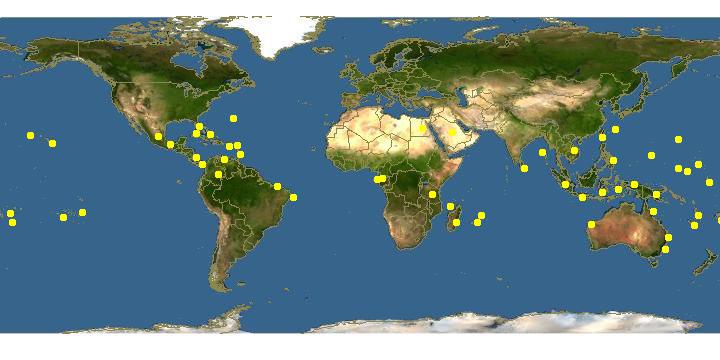Home Sweet Home (Habitat)
Pseudosquilla ciliata are
aquatic
organisms commonly referred to as mantis shrimp (Caldwell, 2005). This
organism is predominantly found in shallow locations of tropical and
sub-tropical bodies of water near coral reefs, grass flats, reef beds,
and sandy bottoms along with other mantis shrimp, small fish, and
worms
(Caldwell, 2005; Manning and Reaka, 1981).

An interactive P. ciliata map from Discover Life. Click here to get started!
The information in this paragraph is from an article by Reaka in 1980. Pseudosquilla ciliata live specifically in burrows from an excavated hole within the mud or in the crevice of large masses of coral. Burrows are essential for aiding in the lifestyle of stomatopods. Many of their daily activities and life events take place in burrows. Typically burrows are used when a stomatopod takes place in mating, brooding eggs, and ecdysis - molting.
According
to a secondary research article by Reaka in 1980, a study was done at
the Hawaii Institute of Marine Biology where biologists observed
stomatopods’ behavior. Their behavior was based on exposure to
experimental flasks
,which were set up to resemble burrows. This study not only consisted
of varying ranges of time a certain individual (from a sample of
fifty-eight) was or was not exposed to flasks which, but also there were
three different sizes and colors of flasks being placed in various
directions per individual. Biologist presented the flasks to the mantis
shrimp for different amounts of time and under different conditions like
the tilt of the flask, the size of the flask, etc. The results confirmed that there was no
preference to any flask more than another, and that the stomatopods were
able to adapt to their new terrestrial environment as predicted. This
study specifically shows how adaptive P. ciliata are to even the
slightest of changes in their habitat.
According to biologist R.A. Kinzie’s study in
1968, Pseudosquilla ciliata is an adaptable organism. P.
ciliata are specific species of crustaceans that are not restricted
to any one certain type of habitat (Manning and Reaka, 1981). P.
ciliata are able to make use of these very different environmental
distinctions in varying habitats such as grass flats, coral reefs, and
coral rubble (Manning and Reaka, 1981). For example, in Hawaii, after
the post war development, P. ciliata filled many new habitats of
the sub-tropical waters unlike anything other stomatopods would have the
ability to do after being exposed to a similar situation (Manning and
Reaka, 1981).
Click to continue to the Adaptations!
Or click to return Home!